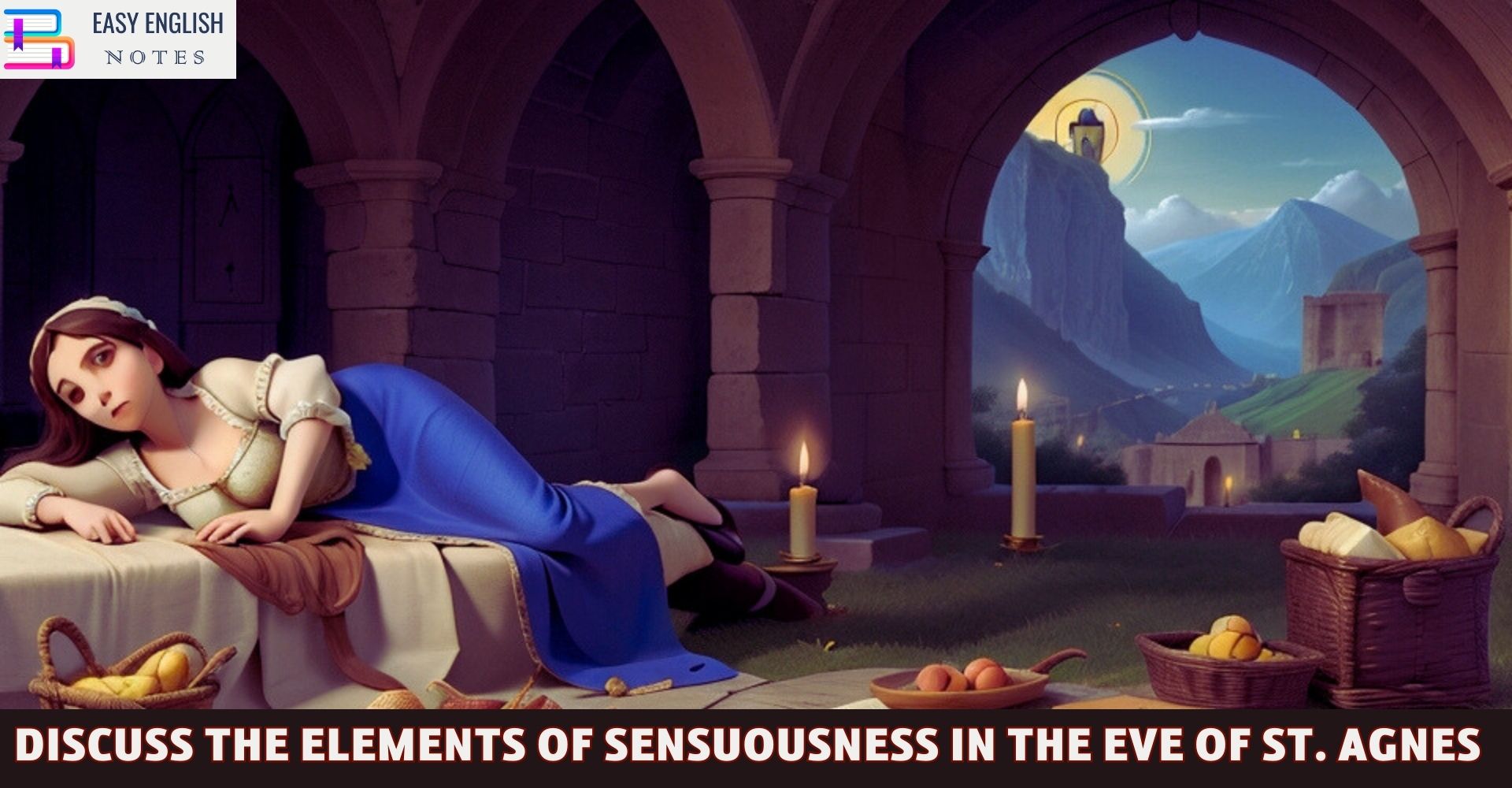“The Eve of St. Agnes,” written by John Keats, is a masterpiece of romantic poetry that vividly portrays sensuous imagery and atmosphere. Through its lush descriptions, evocative language, and intricate sensory details, the poem transports readers into a world of passion, desire, and enchantment. Keats’s skillful use of sensory elements plays a pivotal role in creating a heightened and immersive experience for the audience.
1. Visual Imagery:
Keats’s use of visual imagery in “The Eve of St. Agnes” is particularly striking. He meticulously describes the physical surroundings, creating a detailed mental picture for the reader. For instance, when describing Madeline’s chamber, he uses phrases like “silken, hush’d, and chaste” to convey the luxurious and tranquil atmosphere. The use of colors, such as “deep-damask’d crimson,” adds depth to the imagery, allowing the reader to imagine the vivid and opulent setting. This visual imagery serves as a gateway into the world of the poem, helping readers connect with the characters and their emotions.
2. Tactile Sensations:
Keats’s inclusion of tactile sensations enhances the sensory experience, making the reader feel as if they are physically present in the scene. Descriptions like “carpet, silent, hush’d, and chaste” evoke a sense of coziness and comfort. When Porphyro’s fingers touch the latch, there is a palpable sense of intimacy and anticipation. These tactile details add a layer of realism to the narrative, allowing readers to immerse themselves in the characters’ environment.
3. Auditory Imagery:
Auditory imagery is used by Keats to evoke sounds and noises that contribute to the overall atmosphere of the poem. The “hush’d” and “whispering” sounds within Madeline’s chamber create an aura of secrecy and intimacy, enhancing the romantic mood. The mention of the chapel’s organ music and the howling wind outside the castle adds depth to the soundscape, making the poem more immersive. The auditory elements further engage the reader’s imagination, drawing them into the auditory world of the narrative.
4. Olfactory Descriptions:
Keats appeals to the sense of smell through olfactory descriptions that enhance the sensory experience. The delicate scent of a “rose-bloom” associated with Madeline reflects her purity and allure. The description of Madeline “breathing like a slumbering bride” adds a sensual layer to the imagery, making the reader feel as if they are experiencing the scents themselves. These olfactory details contribute to the overall atmosphere of romance and desire.
Also Read :
- Compare Hamlet with Macbeth, Othello and other Tragedies
- “The Pardoner’s Tale” is the finest tale of Chaucer
- Prologue to Canterbury Tales – (Short Ques & Ans)
- Confessional Poetry – Definition & meaning
5. Gustatory Details:
While gustatory details are not as prominent in the poem, they still contribute to the overall sensory experience. The feast prepared by Porphyro includes “grapes for the asking” and “sweetmeats in the vessels.” These descriptions suggest a banquet of delicacies, alluding to the indulgence and pleasure associated with romantic encounters. The inclusion of gustatory details adds to the overall richness of the sensory tapestry Keats weaves.
6. Symbolism and Sensuality:
The sensuous elements in the poem often carry symbolic significance related to themes of love, desire, and passion. The luxurious tapestries, silks, and warmth in Madeline’s chamber reflect her longing for Porphyro and her readiness to embrace the romantic atmosphere of St. Agnes Eve. These physical surroundings become extensions of the characters’ emotions and intentions. The sensuousness of the setting mirrors the sensuality of their emotions.
7. Romantic and Erotic Imagery:
Keats’s use of sensuous elements adds to the romantic and occasionally erotic atmosphere of the poem. The descriptions of Madeline’s undressing and the passionate gaze exchanged between Madeline and Porphyro contribute to an alluring ambiance that resonates with themes of love and desire. The poem’s sensuality serves to heighten the emotional intensity of the characters’ interactions and feelings.
8. Lyrical Language and Melodic Flow:
Keats’s lyrical language and melodic verse contribute to the overall sensuous experience. His choice of words and the rhythmic flow of his lines create a musical quality that enhances the sensory dimensions of the poem. The musicality of Keats’s language mirrors the ebb and flow of emotions, drawing the reader into the heightened feelings of the characters and the enchanting atmosphere of the narrative.
9. The Role of Sensuousness in Theme and Mood:
Sensuous elements play a pivotal role in enhancing the themes and mood of the poem. The vivid sensory descriptions amplify the theme of passion and romance. The lush, almost decadent portrayals of the surroundings and the characters’ emotions intensify the mood of enchantment and anticipation. The sensory details effectively convey the magical and dreamlike atmosphere of St. Agnes Eve, aligning with the mystical elements of the narrative.
10. Impact on Reader Engagement:
The sensory richness of the poem heightens reader engagement and emotional connection. By appealing to multiple senses, Keats invites readers to experience the world of the poem in a deeply immersive way. This engagement allows readers to empathize with the characters’ feelings and desires, making the narrative more relatable and emotionally resonant. The sensuousness of the poem draws readers into a world of heightened sensations, fostering a deeper connection between the reader and the text.
Conclusion:
“The Eve of St. Agnes” demonstrates John Keats’s masterful use of sensuous elements to create a rich and immersive reading experience. Through vivid imagery, evocative language, and symbolism, Keats transports readers into a world of passion, desire, and enchantment. The sensory details not only enhance the themes and mood of the poem but also foster a deeper emotional connection between the reader and the narrative. Keats’s ability to engage multiple senses simultaneously showcases his poetic craftsmanship and his ability to evoke a range of emotions through sensory-rich storytelling. “The Eve of St. Agnes” remains a timeless example of the power of poetry to create a multisensory experience that resonates with readers across generations.
PLEASE HELP ME TO REACH 1000 SUBSCRIBER ON MY COOKING YT CHANNEL (CLICK HERE)











